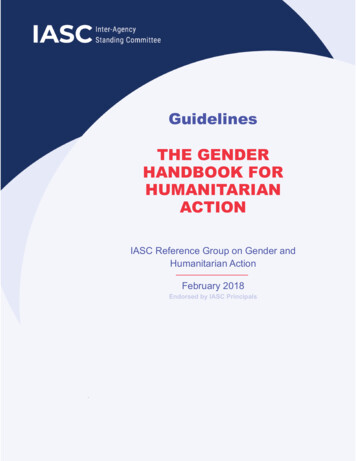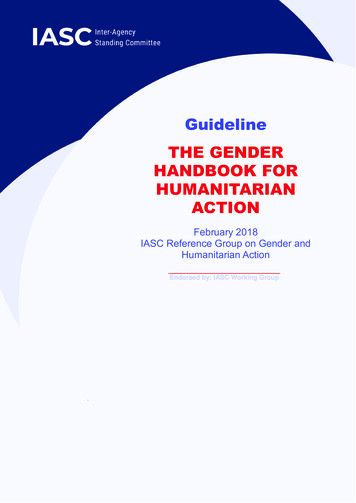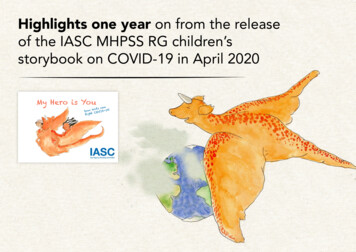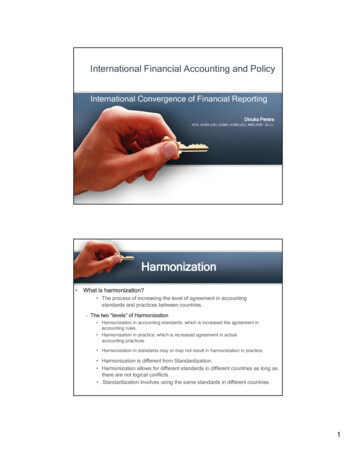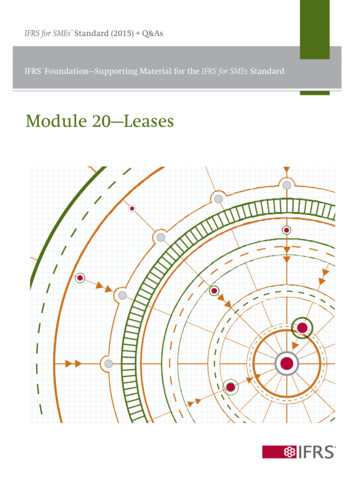
Transcription
IFRS for SMEs Standard (2015) Q&AsIFRS Foundation—Supporting Material for the IFRS for SMEs StandardModule 20—Leases
IFRS FoundationSupporting Materialfor the IFRS for SMEs Standardincluding the full text ofSection 20 Leasesof the IFRS for SMEs Standardissued by the International Accounting Standards Board in October 2015with extensive explanations, self-assessment questions and case studiesIFRS FoundationColumbus Building7 Westferry CircusCanary WharfLondon E14 4HDUnited KingdomTelephone: 44 (0)20 7246 6410Email: info@ifrs.orgWeb: www.ifrs.orgPublications DepartmentTelephone: 44 (0)20 7332 2730Email: publications@ifrs.org
This module has been prepared by IFRS Foundation (Foundation) education staff. It has not been approved by the International AccountingStandards Board (Board). The module is designed to assist users of the IFRS for SMEs Standard (Standard) to implement and consistentlyapply the Standard.All rights, including copyright, in the content of this publication are owned by the IFRS Foundation.Copyright 2019 IFRS Foundation. All rights reserved.Email: info@ifrs.org Web: www.ifrs.orgDisclaimer: All implied warranties, including but not limited to the implied warranties of satisfactory quality, fitness for a particularpurpose, non-infringement and accuracy, are excluded to the extent that they may be excluded as a matter of law. To the extent permittedby applicable law, the Board and the Foundation expressly disclaim all liability howsoever arising whether in contract, tort or otherwise(including, but not limited to, liability for any negligent act or omissions) to any person in respect of any claims or losses of any nature,arising directly or indirectly from: (i) anything done or the consequences of anything done or omitted to be done wholly or partly inreliance upon the whole or any part of the contents of this publication; and (ii) the use of any data or materials contained in thispublication or otherwise. To the extent permitted by applicable law, the Board, the Foundation, the authors and the publishers shall not beliable for any loss or damage of any kind arising from use of and/or reliance on the contents of this publication or any translation thereof,including but not limited to direct, indirect, incidental or consequential loss, punitive damages, penalties or costs.Information contained in this publication does not constitute advice and should not be used as a basis for making decisions or treated as asubstitute for specific advice on a particular matter from a suitably qualified professional person. For relevant accounting requirements,reference must be made to the Standard issued by the Board.Any names of individuals, companies and/or places used in this publication are fictitious and any resemblance to real people, entities orplaces is purely coincidental.Right of use: Although the Foundation encourages you to use this module for educational purposes, you must do so in accordance with theterms of use below. If you intend to include our material in a commercial product, please contact us as you will need a separate licence. Fordetails on using our Standards, please visit www.ifrs.org/issued-standards.You must ensure you have the most current material available from our website. Your right to use this module will expire when this moduleis withdrawn or updated, at which time you must cease to use it and/or make it available. It is your sole responsibility to ensure you are usingrelevant material by checking the Foundation’s website for any amendments to the Standard, SME Implementation Group Q&As not yetincorporated and/or new versions of the modules.Terms of Use1)You can only reproduce the module in whole or in part in a printed or electronic stand-alone document provided that:(a) such document is supplied to participants free of charge;(b) you do not use or reproduce, or allow anyone else to use or reproduce, the Foundation logo that appears on or in the module;(c) you do not use or reproduce any trade mark that appears on or in the module if you are using all or part of the material toincorporate into your own documentation; and(d) you can only provide this module in whole through your website if you include a prominent link to our website (please see ourterms and conditions page for details on how to link your website to ours).2)The trade marks include those listed below.3)When you copy any extract from this publication for inclusion in another document you must ensure:(a) the documentation includes a copyright acknowledgement;(b) the documentation includes a statement that the Foundation is the author of the module and that the original module can beaccessed via the IFRS website www.ifrs.org;(c) the documentation includes in a prominent place an appropriate disclaimer, like that shown above;(d) the extract is shown accurately; and(e) the extract is not used in a misleading context.If you intend to provide any part of this module in print or electronically for any other purpose, please contact the Foundation as you willneed a written licence which may or may not be granted. For more information, please contact the licences ng).Please address publication and copyright matters to the IFRS Foundation Publications Department:Email: publications@ifrs.org Web: www.ifrs.orgTrade mark noticeThe IFRS Foundation has trade marks registered around the world, including ‘eIFRS ’, ‘International Accounting Standards ’, ‘IAS ’, ‘IASB ’,the IASB logo, ‘IFRIC ’, ‘International Financial Reporting Standards ’, ‘IFRS ’, the IFRS logo, ‘IFRS Foundation ’, ‘IFRS for SMEs ’, theIFRS for SMEs logo, the ‘Hexagon Device’, ‘NIIF ’ and ‘SIC ’. Further details of the IFRS Foundation’s trade marks are available from theIFRS Foundation on request.
ContentsINTRODUCTIONWhich version of the IFRS for SMEs StandardThis moduleIFRS for SMEs StandardIntroduction to the requirementsWhat has changed since the 2009 IFRS for SMEs Standard111234REQUIREMENTS AND EXAMPLES 5Scope of this Section 5Classification of leases 8Financial statements of lessees–finance leases 19Financial statements of lessees–operating leases 33Financial statements of lessors–finance leases 43Financial statements of lessors–operating leases 53Sale and leaseback transactions 61SIGNIFICANT ESTIMATES AND OTHER MPARISON WITH FULL IFRS STANDARDS 70TEST YOUR KNOWLEDGE 72APPLY YOUR KNOWLEDGECase study 1Answer to case study 1Case study 2Answer to case study 2IFRS Foundation: Supporting Material for the IFRS for SMEs Standard (version 2019-01)7979818587
Module 20—LeasesThe accounting requirements applicable to small and medium-sized entities (SMEs)discussed in this module are set out in the IFRS for SMEs Standard, issued by theInternational Accounting Standards Board (Board) in October 2015.This module has been prepared by IFRS Foundation education staff.The contents of Section 20 Leases of the IFRS for SMEs Standard are set out in thismodule and shaded grey. The Glossary of terms of the IFRS for SMEs Standard(Glossary) is also part of the requirements. Terms defined in the Glossary are reproducedin bold type the first time they appear in the text of Section 20. The notes and examplesinserted by the education staff are not shaded. These notes and examples do not formpart of the IFRS for SMEs Standard and have not been approved by the Board.INTRODUCTIONWhich version of the IFRS for SMEs Standard?When the IFRS for SMEs Standard was first issued in July 2009, the Board said it wouldundertake an initial comprehensive review of the Standard to assess entities’ experience of thefirst two years of its application and to consider the need for any amendments. To this end, inJune 2012, the Board issued a Request for Information: Comprehensive Review of the IFRS for SMEs.An Exposure Draft proposing amendments to the IFRS for SMEs Standard was subsequentlypublished in 2013, and in May 2015 the Board issued 2015 Amendments to the IFRS for SMEsStandard.The document published in May 2015 only included amended text, but in October 2015, theBoard issued a fully revised edition of the Standard, which incorporated additional minoreditorial amendments as well as the substantive May 2015 revisions. This module is based onthat version.The IFRS for SMEs Standard issued in October 2015 is effective for annual periods beginning onor after 1 January 2017. Earlier application was permitted, but an entity that did so wasrequired to disclose the fact.Any reference in this module to the IFRS for SMEs Standard refers to the version issued inOctober 2015.This moduleThis module focuses on the accounting of leases applying Section 20 Leases of the IFRS for SMEsStandard. It introduces the subject and reproduces the official text along with explanatorynotes and examples designed to enhance understanding of the requirements. The moduleidentifies the significant judgements required in accounting for leases. In addition, themodule includes questions designed to test your understanding of the requirements and casestudies that provide a practical opportunity to apply the requirements on accounting forleases in the IFRS for SMEs Standard.IFRS Foundation: Supporting Material for the IFRS for SMEs Standard (version 2019-01)1
Module 20—LeasesUpon successful completion of this module, you should, within the context of the IFRS for SMEsStandard, be able to: identify lease arrangements that qualify for recognition under this Standard; distinguish between finance leases and operating leases; recognise and measure the rights and obligations that arise from finance leases in thefinancial statements of the lessee and those of the lessor; measure the recognised assets and liabilities after their initial recognition in the financialstatements of the lessee and those of the lessor; account for lease payments that arise from operating leases in the financial statements ofthe lessee and those of the lessor; present and disclose leases in the financial statements of the lessee and those of the lessor;and demonstrate an understanding of the significant judgements that are required inaccounting for leases.IFRS for SMEs StandardThe IFRS for SMEs Standard is intended to apply to the general purpose financial statements ofentities that do not have public accountability (see Section 1 Small and Medium-sized Entities).The IFRS for SMEs Standard is comprised of mandatory requirements and other non-mandatorymaterial.The non-mandatory material includes: a preface, which provides a general introduction to the IFRS for SMEs Standard and explainsits purpose, structure and authority;implementation guidance, which includes illustrative financial statements and a table ofpresentation and disclosure requirements;the Basis for Conclusions, which summarises the Board’s main considerations in reachingits conclusions in the IFRS for SMEs Standard issued in 2009 and, separately, in the 2015Amendments; andthe dissenting opinion of a Board member who did not agree with the issue of theIFRS for SMEs Standard in 2009 and the dissenting opinion of a Board member who did notagree with the 2015 Amendments.In the IFRS for SMEs Standard, Appendix A: Effective date and transition, and Appendix B:Glossary of terms, are part of the mandatory requirements.In the IFRS for SMEs Standard, there are appendices to Section 21 Provisions and Contingencies,Section 22 Liabilities and Equity and Section 23 Revenue. These appendices providenon-mandatory guidance.The IFRS for SMEs Standard has been issued in two parts: Part A contains the preface, all themandatory material and the appendices to Section 21, Section 22 and Section 23; and Part Bcontains the remainder of the material mentioned above.Further, the SME Implementation Group (SMEIG), which assists the Board with supportingimplementation of the IFRS for SMEs Standard, publishes implementation guidance as‘questions and answers’ (Q&As). These Q&As provide non-mandatory, timely guidance onIFRS Foundation: Supporting Material for the IFRS for SMEs Standard (version 2019-01)2
Module 20—Leasesspecific accounting questions raised with the SMEIG by entities implementing the IFRS for SMEsStandard and other interested parties. At the time of issue of this module (January 2019) theSMEIG has not issued any Q&As relevant to this module.Introduction to the requirementsThe objective of general purpose financial statements of a small or medium-sized entity is toprovide information about the entity’s financial position, performance and cash flows that isuseful for economic decision-making by a broad range of users who are not in a position todemand reports tailored to meet their particular information needs. Such users include, forexample, owners who are not involved in managing the business, existing and potentialcreditors and credit rating agencies.The objective of Section 20 is to prescribe the accounting and disclosure requirements forleases in the financial statements of lessees and lessors.A lease is an agreement whereby the lessor conveys to the lessee in return for a payment or aseries of payments the right to use an asset for an agreed period of time.Lease classificationA primary issue in accounting for leases is the classification of the lease as either a financelease or an operating lease. A finance lease transfers substantially all the risks and rewardsincidental to ownership. An operating lease does not.Finance leasesA lessee accounts for a finance lease as a purchase of an asset on credit (ie at thecommencement of the lease the lessee recognises the rights and obligations arising from thelease at amounts equal to the fair value of the leased asset or, if lower, the present value of theminimum lease payments). Conversely, a lessor (including a manufacturer or dealer lessor)that has previously recognised the asset accounts for a finance lease as the sale of an asset oncredit. The future amounts receivable under the terms of lease are recognised by any lessor asa receivable.After initial recognition of a finance lease the lessee accounts for the leased asset inaccordance with other sections of the IFRS for SMEs Standard (eg Section 17 Property, Plant andEquipment). The lessee apportions the minimum lease payments between finance charge(interest expense) and repayment of the finance lease liability using the effective interestmethod. The lessor apportions the minimum lease payments between finance income on thereceivable and repayment of the finance lease receivable using the effective interest method.Operating leasesThe lessee and the lessor recognise lease payments under operating leases in profit or loss onthe straight-line basis over the lease term unless specific exceptions apply (eg anothersystematic basis is representative of the time pattern of the user’s benefit).Sale and leaseback transactionsA sale and leaseback transaction involves the sale of an asset and the leasing back of the sameasset. The lease payment and the sale price are usually interdependent because they arenegotiated as a package. The accounting treatment of a sale and leaseback transactiondepends on the type of lease (ie finance lease or operating lease).IFRS Foundation: Supporting Material for the IFRS for SMEs Standard (version 2019-01)3
Module 20—LeasesWhat has changed since the 2009 IFRS for SMEs StandardThe following are the changes made to Section 17 by the 2015 Amendments: Modification to include leases with an interest rate variation clause that is linked tomarket interest rates within the scope of Section 20 instead of Section 12 (see paragraph20.1(e)). Clarification that only some outsourcing arrangements, telecommunication contracts thatprovide rights to capacity and take-or-pay contracts are, in substance, leases (see paragraph20.3).In addition, this module reproduces other editorial changes.IFRS Foundation: Supporting Material for the IFRS for SMEs Standard (version 2019-01)4
Module 20—LeasesREQUIREMENTS AND EXAMPLESScope of this section20.1This section covers accounting for all leases other than:(a) leases to explore for or use minerals, oil, natural gas and similar non-regenerativeresources (see Section 34 Specialised Activities);(b) licensing agreements for such items as motion picture films, video recordings, plays,manuscripts, patents and copyrights (see Section 18 Intangible Assets other thanGoodwill);(c) measurement of property held by lessees that is accounted for as investmentproperty and measurement of investment property provided by lessors underoperating leases (see Section 16 Investment Property);(d) measurement of biological assets held by lessees under finance leases andbiological assets provided by lessors under operating leases (see Section 34);(e) leases that could lead to a loss to the lessor or the lessee as a result of contractualterms that are unrelated to changes in the price of the leased asset, changes in foreignexchange rates, changes in lease payments based on variable market interest rates,or a default by one of the counterparties (see paragraph 12.3(f)); and(f) operating leases that are onerous.NotesA lease is an agreement whereby the lessor conveys to the lessee in return for paymentor a series of payments the right to use an asset for an agreed period of time (seeGlossary).Operating leases that are onerous are outside the scope of Section 20. However, theyare dealt with by Section 21 (see paragraph 21.1(a)).Examples – scope of Section 20Ex 1An entity owns a property to earn rentals and for capital appreciation. It entersinto an agreement whereby it grants an independent third party the right to usethe building for 10 years in return for payment of CU1,000(1) per year.The independent third party (lessee) intends using the building for its head office.The arrangement is not considered onerous for either party.The arrangement is a lease—it is an agreement whereby the lessor (the entity) conveysto the lessee (the independent third party) in return for payment or a series ofpayments (payment of CU1,000 per year) the right to use an asset (the building) for anagreed period of time (10 years).Lessor’s perspectiveThe property is an investment property (ie held to earn rentals and for capitalappreciation, see Section 16 Investment Property paragraph 16.2). The measurement ofthe investment property is outside the scope of Section 20 (see paragraph 20.1(c)).The investment property is accounted for in accordance with Section 16 InvestmentProperty. However, the lease income is accounted for in accordance with Section 20.The disclosures required by Section 20 must also be presented.(1)In this example, and in all other examples in this module, monetary amounts are denominated in ‘currency units (CU)’.IFRS Foundation: Supporting Material for the IFRS for SMEs Standard (version 2019-01)5
Module 20—LeasesLessee’s perspectiveThe lease is accounted for in accordance with Section 20.Ex 2An entity (as the lessee) leases a building under an operating lease from anindependent third party (the owner of the property). Furthermore, the entity (asthe lessor) subleases the building under operating leases to various independentthird parties who occupy the property. The entity profits from its leaseholdinterest in the building by charging a higher amount to its tenants than it ischarged by its landlord. In accordance with paragraph 16.3 the entity elected toaccount for its interest in the building as an investment property. The entity canmeasure reliably the fair value of the property interest without undue cost oreffort on an ongoing basis. The arrangement is not considered onerous for eitherparty.The arrangement is a lease—it is an agreement whereby the lessor conveys to the lessee(the entity) in return for payment or a series of payments the right to use an asset foran agreed period of time.The entityThe entity elected to account for its interest in the building as an investment property.Therefore, in spite of the classification of the arrangement, it accounts for its interestin the building in accordance with Section 16 (see paragraph 16.6)—ie recognise anasset (investment property) and a liability (obligation to make lease payments)—ratherthan Section 20 (see paragraph 20.1(c)).Note: If the entity cannot measure the fair value of its interest in the property reliablywithout undue cost or effort it is prohibited from electing to account for its leaseholdinterest in the building as an item of investment property see Section 16 InvestmentProperty paragraph 16.4). In those circumstances the requirements in Section 20pertaining to operating leases would apply.The entity’s lessor (the owner of the property)The property is an investment property. The measurement of the investment propertyis outside the scope of Section 20 (see paragraph 20.1(c)). The investment property isaccounted for in accordance with Section 16 Investment Property. However, the leaseincome is accounted for in accordance with Section 20. The disclosures required bySection 20 must also be presented.The entity’s lessees (the occupants of the property)The entity’s lessees would account for the lease in accordance with Section 20.Ex 3An entity created a motion picture film. In return for a series of royalty paymentsthe entity licenses various cinema operators worldwide to show the film incinemas operated by the licensees for a 12-month period.The arrangement is a lease—it is an agreement whereby the lessor (the entity) conveysto the lessee (the cinema operators worldwide) in return for payment or a series ofpayments (the royalty payments) the right to use an asset for an agreed period of time(the 12-month period).IFRS Foundation: Supporting Material for the IFRS for SMEs Standard (version 2019-01)6
Module 20—Leases20.2However, the licensing arrangement is not accounted for in accordance with Section20. It is accounted for in accordance with Section 18 Intangible Assets other than Goodwill(see paragraph 20.1(b)).This section applies to agreements that transfer the right to use assets even thoughsubstantial services by the lessor may be called for in connection with the operation ormaintenance of such assets. This section does not apply to agreements that are contractsfor services that do not transfer the right to use assets from one contracting party to theother.Example – lease with other servicesEx 4An entity leases a photocopier from an independent third party under anoperating lease. As part of that agreement the lessor agrees to providemaintenance services to the lessee in respect of the photocopier.The arrangement contains a lease—it is an agreement whereby the lessor (theindependent third party) conveys to the lessee the right to use an asset for an agreedperiod of time, in addition to the provision of services.Lessee’s and Lessor’s perspectiveEven though the lessor also agrees to provide maintenance services, 20.2 still requiresan arrangement that contains a lease be accounted for under Section 20.20.3Some arrangements, such as some outsourcing arrangements, telecommunicationcontracts that provide rights to capacity and take-or-pay contracts, do not take the legalform of a lease but convey rights to use assets in return for payments. Such arrangementsare in substance leases of assets and they shall be accounted for under this section.Example – an arrangement that contains a leaseEx 5 Company A enters into an arrangement to supply gas to Company B. For thispurpose, Company A designs and builds a facility adjacent to Company B toproduce the needed gas. Gas cannot be provided to Company B from anotherfacility, and no one else does or can benefit from its use. In terms of theagreement, Company B determines how much gas is supplied each month basedon its needs. It pays Company A a fixed amount each month, in addition to avariable amount proportional to monthly supply.The arrangement contains a lease within the scope of Section 20 — it is an agreementthat conveys the right for Company B to use the facility in return for payments.Company B has obtained the right to use the facility because it has been built only tomeet its needs and it has control over the quality of gas produced. It should thereforebe accounted for as a lease.IFRS Foundation: Supporting Material for the IFRS for SMEs Standard (version 2019-01)7
Module 20—LeasesClassification of leases20.4A lease is classified as a finance lease if it transfers substantially all the risks and rewardsincidental to ownership. A lease is classified as an operating lease if it does not transfersubstantially all the risks and rewards incidental to ownership.NotesTo be classified as a finance lease, the lease must transfer substantially all the risks andrewards incidental to ownership. All other leases are operating leases.Risks include the possibilities of losses from idle capacity or technologicalobsolescence, and of variations in return because of changing economic conditions(including changes in the value of any residual interest).Rewards may be represented by the expectation of profitable operation over the asset’seconomic life and of gain from appreciation in value of any residual interest.‘Substantially all’ is a high hurdle and the finance lease classification is typically notappropriate in cases in which the lessor retains more than significant risks andrewards of ownership.In most cases the same classification (finance lease or operating lease) is appropriatefor both the lessee and the lessor. However, in some cases different classifications areappropriate.Example – finance lease classificationEx 6On 1 January 20X1 an entity entered, as lessee, into a five-year non-cancellablelease of a machine that has an economic life of five years and nil residual value.On 1 January 20X1 (the inception of the lease) the fair value (cash cost) of themachine is CU100,000.On 31 December for each of the first four years of the lease term the lessee isrequired to pay the lessor CU23,000. At the end of the lease term, ownership ofthe machine passes to the lessee upon payment of the final lease payment ofCU23,539.The interest rate implicit in the lease is 5% per year. This rate approximates thelessee’s incremental borrowing rate.The arrangement is a finance lease. On 1 January 20X1 the lease transfers substantiallyall the risks and rewards incidental to ownership from the lessor to the lessee.In substance the lessee now owns the machine. The lessee is the party that benefitsfrom the use of the leased asset during its entire expected economic life.Examples – operating lease classificationEx 7On 1 January 20X1 an entity entered, as lessee, into a five-year non-cancellablelease of farmland with a fair value (cash cost) of CU100,000.The lessee is required to pay the lessor CU5,000 per year.The arrangement is an operating lease. The lease does not transfer substantially all therisks and rewards incidental to ownership from the lessor to the lessee (eg gains andlosses in the fair value of the farmland accrue to the benefit of the lessor during andIFRS Foundation: Supporting Material for the IFRS for SMEs Standard (version 2019-01)8
Module 20—Leasesafter the lease agreement). The lessee merely has the temporary right of use of thefarmland for a small part (five years) of the indefinite economic life of the farmland.Ex 8On 1 January 20X1 an entity entered, as lessee, into a five-day non-cancellablelease of a motor vehicle that has an economic life of five years and nil residualvalue.On 1 January 20X1 (the inception of the lease), the fair value (cash cost) of themotor vehicle is CU100,000.The lessor charges the lessee CU120 per day for the use of the motor vehicle. Atthe end of the lease term the lessee returns the motor vehicle to the lessor.The arrangement is an operating lease. The lease does not transfer substantially all therisks and rewards incidental to ownership from the lessor to the lessee. The lesseemerely obtains the right to use the lessor’s motor vehicle for a small part (five days) ofthe economic life (five years) of the vehicle.Example – multiple parties to a lease classificationEx 9A tripartite lease agreement whereby the lessor (Entity A) transfers substantiallyall the risks and rewards of ownership to two unrelated parties—the lessee (EntityB) obtains the right of use of the leased asset for a specified period and the otherparty (Entity C) contracts to acquire the leased asset from the lessor (Entity A) atthe end of the lease term at a fixed price.In this case, the lessor (Entity A) and the lessee (Entity B) would classify the lease as afinance lease and an operating lease respectively.The third party (Entity C) has a firm commitment to acquire the leased asset at the endof the lease term.20.5Whether a lease is a finance lease or an operating lease depends on the substance of thetransaction instead of the form of the contract. Examples of situations that individually orin combination would normally lead to a lease being classified as a finance lease are:(a) the lease transfers ownership of the asset to the lessee by the end of the lease term;(b) the lessee has the option to purchase the asset at a price that is expected to besufficiently lower than the fair value at the date the option becomes exercisable for itto be reasonably certain, at the inception of the lease, that the option will be exercised;(c) the lease term is for the major part of the economic life of the asset even if title is nottransferred;(d) at the inception of the lea
The IFRS for SMEs Standard is intended to apply to the general purpose financial statements of entities that do not have public accountability (see Section 1 Small and Medium-sized Entities). The IFRS for SMEs Standard is comprised of mandatory requirements and other non -mandatory material. The non-mandatory material includes:







